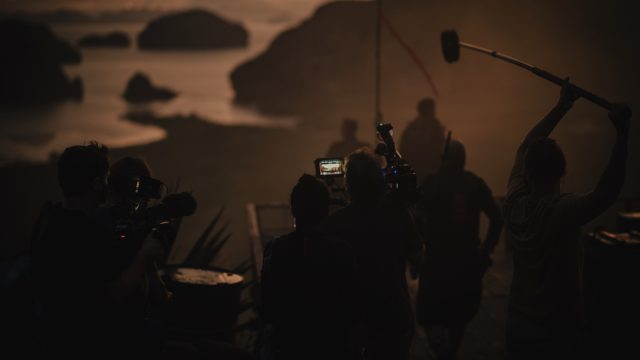This Week the Real Work Is Done By:
- victorious writers
- a legendary FX artist
- a lauded production designer
- several unique camera rigs
- and, we suppose, the director
Thanks to Casper and Jake Gittes for working in the wings this week! Send articles throughout the next week to ploughmanplods [at] gmail, post articles from the past week below for discussion, and Have a Happy Friday!
Get your scorecards out! After the WGA officially signs a new and significantly improved deal and writers go back to work, Vanity Fair‘s Natalie Jarvey and Joy Press report on the winners and losers of the strike:
At the recently resurrected Amicus Productions, Lawrie Brewster talks to legendary FX artist Dave Elsey on his relationship with Amicus and Hammer horror and valuing practical effects in his work:
Once I’d successfully sneaked downstairs, I’d settle in to watch those films in a state of mild rebellion. Of course, this rebellion came with the TV volume turned down to a mere whisper, just in case I got caught and was sent back to bed without seeing the thrilling conclusions of both movies. The mix of adrenaline, rule-breaking, and sheer love for scary movies was intoxicating. Yes, the movies scared me, but not nearly as much as the fear of getting caught watching them when I was supposed to be tucked in bed. I was addicted to the exhilarating rush of making a secret appointment with fear every Saturday night. Those double bills were the highlight of my week. They typically featured a classic black and white horror film, often a Universal classic, followed by a more modern technicolor horror, usually from Hammer Films or Amicus. There was something enchanting about watching those films in the dark; the colours seemed to come alive.
For The New York Times Magazine Noah Gallagher Shannon profiles Jack Fisk, master production designer for Killers of the Flower Moon, The Thin Red Line, Mulholland Drive and many others:
A former painter and sculptor, Fisk considers his job not merely the designing of authentic period backdrops but the creation of a film’s visual language, a series of subliminal whispers to thematic elements: a character’s taste in home décor, the personal history that selects a bedside photo, the temperament that informs a paint choice. He thinks of his art as one of believability: a nearly invisible composition of landscapes, buildings, paint and props that, when projected onscreen, absorbs the audience in a world that they know — instantly, intimately — is real, though they’ve never seen it before.
Director of Photography for Gareth Edwards’ Creator talks to Matt Mulcahey in Filmmaker Magazine about the freedom of using less expensive rigs and trying to shake off the yoke of previsualizations:
Not only were we not letting the previs drive the photography, there wasn’t a lot of previs. They intentionally saved the design portion of the visual effects until post, which is typically not how it’s done. That’s not to say there wasn’t imagery. There was a ton of concept art and James Clyne, the production designer, was on board during preproduction. So, there were a lot of ideas and sketches, but nothing dictating what we needed to capture on set in order to achieve a specific frame later. […] The beauty of that was it allowed us maximum freedom and flexibility to let the environments and locations dictate the composition and framing. You’re reacting to the geography of a real space and letting that determine the frame, then decisions can be made in post in terms of, “What would a building in the background of this shot need to look like in order to fit this frame perfectly? Are there enough robots in this frame? Does it feel lived in enough?” And if the answer was “no,” then it’s like, “OK, let’s pick two more characters in the background and turn them into robots.” All of that decision making was made in post responding to the edit of the film.
Okay, one above-the-line crew member makes the list as Molly Haskell talks in Film Comment of director Todd Haynes as his new film May December is set to open the New York Film Festival:
Haynes’s later narrative projects—particularly Carol (2015), Mildred Pierce (2011), and now May December—are all masterworks in different but distinctly Haynesian ways. The director still plays with matters of class and identity in these, but in ways both subtler and more challenging. The inexorable presence of class and the endless mystery of identity impinge on one another, forming a kind of shifting, interlocking, almost musical pattern. He’s also proving to be one of the great modern directors of women—of women who go out on a limb (or were born that way), and who must continually find their footing. The sleek blonde protagonist of Carol, played by Cate Blanchett, is so apparently self-possessed, while her unplaceable younger lover, Therese (Rooney Mara), seems “flung out of space.” Kate Winslet’s status-conscious heroine in Mildred Pierce is intimidated by her snooty daughter (Evan Rachel Wood), yet sheds her lumpenness in lit-up delight when she discovers her sexuality with Monty (Guy Pearce).


